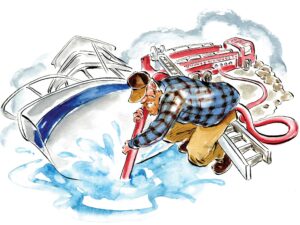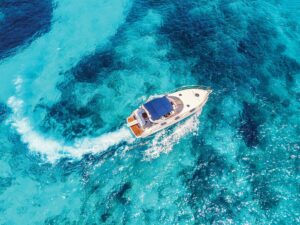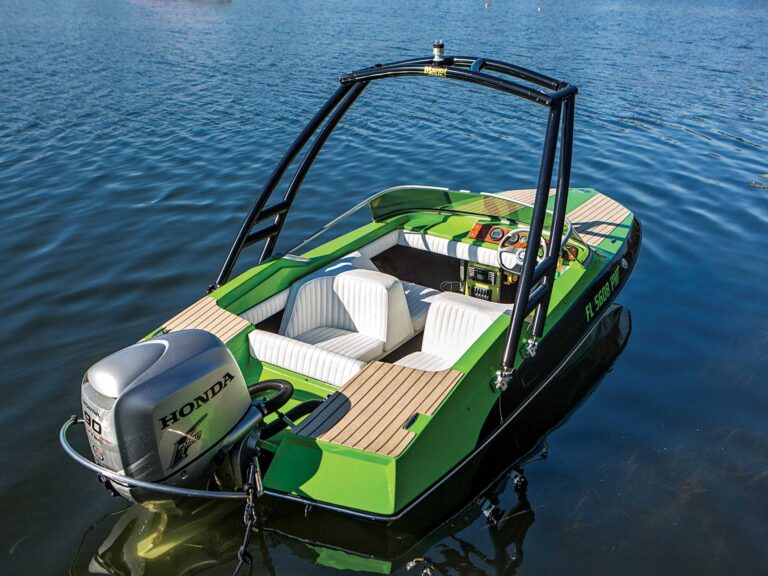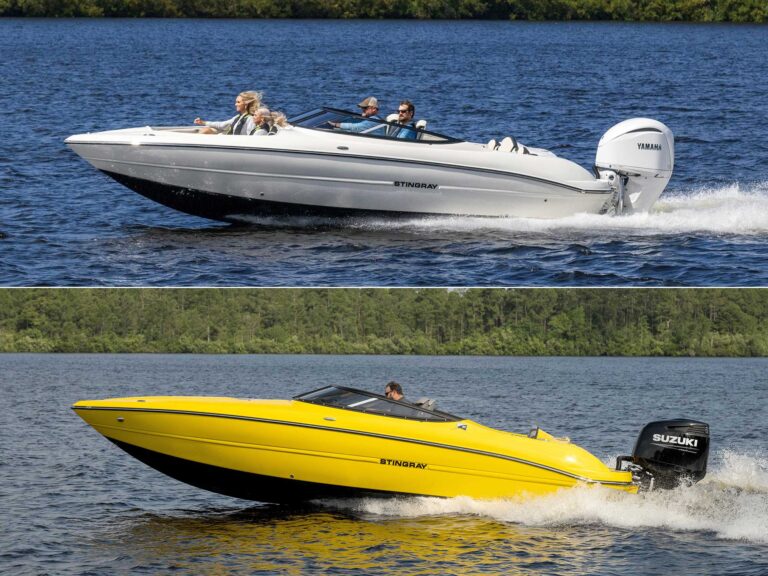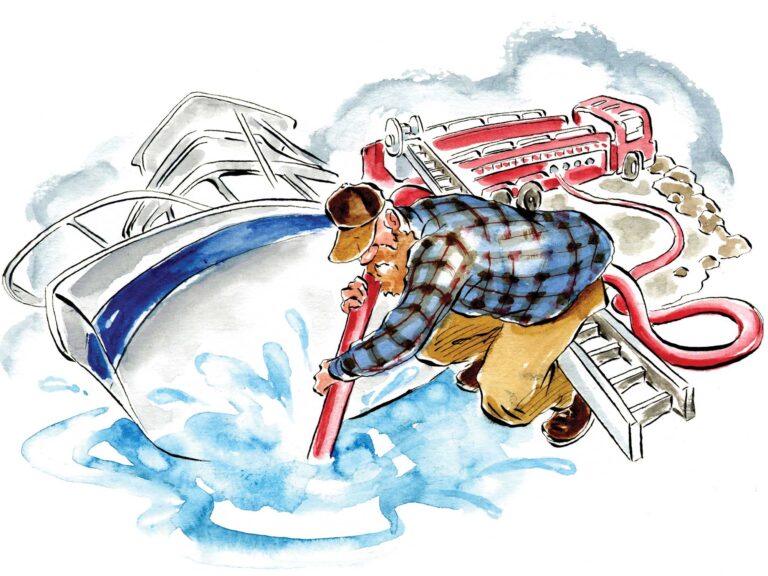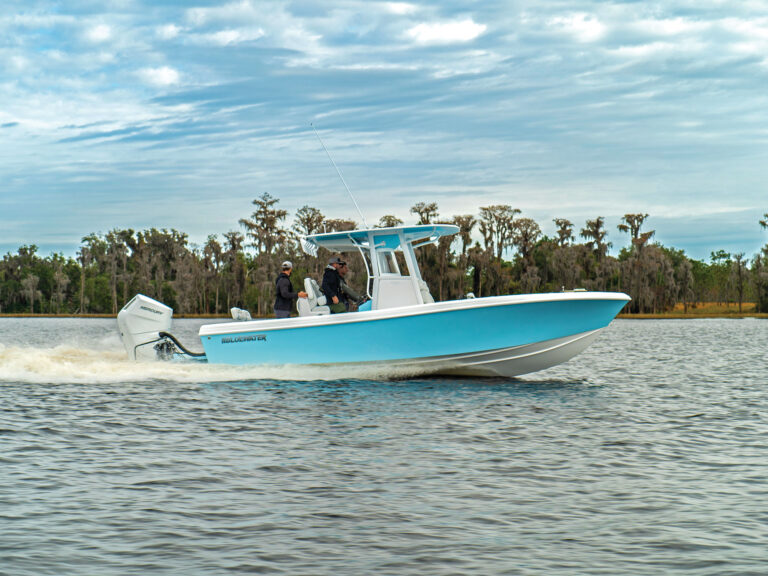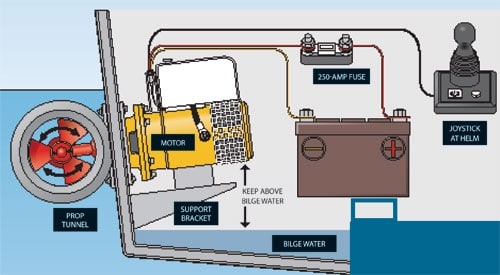
Dan wanted a bow thruster to make close-quarter maneuvering easier on his inboard cruiser. But, like most of us, he didn’t have the nerve to cut a large complicated hole below the waterline nor the professional fiberglassing expertise needed for the job. His other option? An electric stern thruster, which is easy to install on a flat transom, and well within the skills of any do-it-yourselfer. He bought one from Vetus (410/712-0740, www.vetus.nl). The thruster’s joystick control, wiring, and prop/tunnel are all stock, but there are many choices for the electric motor. Vetus helped with this over the phone, as well as with installation questions as the unit’s manual isn’t all that good. The only major complication encountered was that the thruster requires a dedicated 12-volt battery be wired into the boat’s DC charging system.
Parts
Electric motor (ignition protected) Vetus BOW55121, $3,000
Prop/tunnel Vetus Stern 150P, $412
Joystick control Vetus Model BPJE, $273
Fuse holder Vetus ZEHC100, $45
250-amp fuse Vetus ZE250, $16
Wiring harness (33′) Vetus BP2910, $66
12-volt battery 100-to-200-amp-hour
Supplies
• 3⁄8″ electric drill
• 3⁄8″, 1⁄2″ drill bits
• 3″ hole saw
• Jigsaw
• (2) 5⁄8″ wrenches
• 3⁄8″ stainless-steel hex bolts, washers
• Outboard motor gear grease
• Sikaflex 292 sealant (or equivalent)
• Cable ties and clamps
• AWG 000 cable
• Solderless ring terminals
• Heat-shrink tubing
• Heat gun
Installation
Locate the athwartship center of the transom and draw a vertical line. Tape the thrust tunnel’s paper mounting template to the transom. Be sure to line up the template’s “waterline” to your boat’s actual waterline, not the painted one. Check and double-check this. It is essential that the thruster’s tunnel is parallel to the water’s surface.
Before drilling any holes, check inside the boat to be sure that there are no obstructions and that there is a minimum of 1′ of clearance to accommodate the internally mounted motor. Also be sure that no bilge water can reach the installed motor.
Drill six 3⁄8″ holes for the thrust tunnel’s mounting bolts. Next, drill a ½” pilot hole for the jigsaw’s blade and cut a 6½” hole for the motor mount. De-bur fiberglass edges with fine grit sandpaper.
Mount the thruster tunnel to the transom using generous amounts of sealant on both sides of its gasket. Before securing the tunnel, coat the threads on its nuts and bolts with grease to prevent them from seizing in place. Push bolts out from inside the hull, keeping the nuts and lock washers on the outside. Check that the prop still clears the thrust tunnel by a minimum of 1⁄16″.
Mount the motor using its four bolts, applying generous amounts of sealant around its mounting flange. Be sure to grease the nuts and bolts. Before final tightening, spin the prop by hand to be sure it turns easily.
The motor is now hanging by its mounting bolts, which will overstress the transom and mounting flange unless the weight of the motor is supported. We fiberglassed in a wood bracket with a block and shims under the motor. Locate a convenient place at the helm station for the joystick. Be sure that there is rear access and at least 5″ of clearance. Drill a 3″ hole, then slip on the supplied foam gasket and mount. If the location is exposed to the weather, additional sealant is recommended. Connect the joystick to the motor with the wiring harness, supporting the run at least every 1’6″.
Wiring
Install a dedicated 12-volt battery as close to the thruster’s motor as possible. Mount the 250-amp fuse holder between the battery and the motor. Remove the motor’s cover to expose the positive terminal. Run a length of red AWG 000 cable from the battery’s positive terminal to the fuse holder and another length from the fuse to the motor. Run yellow AWG 000 cable from the battery’s negative terminal battery to the motor. Use crimped ring terminals with heat-shrink tubing.
Watch Your Trim
This system weighs a hefty 44 pounds, plus the additional nearby battery. This much weight concentrated at the transom can affect your trim. Check your painted boot stripe after the installation.
What’s a Waterline?
When placing the template on the waterline, be sure to use the actual waterline, not the boot stripe. The actual waterline is the scum mark left on the transom after sitting in the water for a season.
Paint?
Do not paint the prop. It is finely machined and balanced and will clean itself every time it is activated. The thruster tunnel is fiberglass and must be painted.
Charge It
When installing the dedicated battery, be sure to wire it into a charging source. No charge, no thrust.
Dedicated Battery
• Deep-cycle battery in covered box with external strapping with no more than 1″ movement in any direction.
• Cover the positive terminal with cable cap.
• Keep out of areas that exceed 1200F.
• Never put above a fuel tank, fuel filter, or fuel line fitting.
• Any metallic fuel system component within a foot must be electrically insulated.

